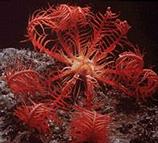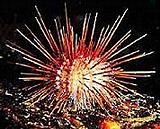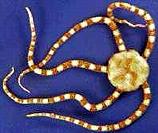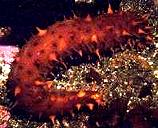
(feather star) |

(starfish) |
Phylum ECHINODERMATA
(traits & tree after
|

(sea urchin) |
|

(brittle star) |

(sea cucumber) |

(feather star) |

(starfish) |
Phylum ECHINODERMATA
(traits & tree after
|

(sea urchin) |
|

(brittle star) |

(sea cucumber) |
==1================================= Crinoidea (sea lilies, feather stars)
<<=E====|
| ==4=============== Asteroidea ('true' starfish)
| ====3====|
| | ==5=============== Ophiuroidea (brittle stars)
===2=====|
| ==7=============== Echinoidea (sea urchins)
====6====|
==8=============== Holothuroidea (sea cucumbers)
Back to Zool 250 tree for animal phyla or Deuterostomia.
TRAITS SUPPORTING EACH CLADE (** plesiomorphic- a primitive state, not unique to clade):
|
b) endoskeleton of calcareous ossicles with unique perforated structure c) unique water vascular system with suckerless podia d) open ambulacral grooves e) mouth & anus on oral surface** f) sessile; attached to substratum with aboral surface (primitively) g) multiple gonads** # h) spherical sperm** # i) gill pores/slits absent in adults j) monociliated cells** b) multiple arms bearing open ciliated grooves for suspension feeding c) podia lack suckers**, not used for locomotion d) use articulated cirri for locomotion (derived forms) e) vitellaria larvae b) oral surface becomes ventral c) anus becomes dorsal d) use podia (tube feet) for locomotion e) stone canal becomes ossified # f) polian vesicles (or similar) on ring canal |
b) podia possess suckers c) pedicellaria** (2 orders) d) bipinnaria & brachilaria larvae b) arm ossicles like miniature 'vertebrae' c) anus absent in adult d) ophiopleuteus larvae b) ambulacral grooves extend from oral to aboral pole c) aboral surface restricted to small region around anus d) podia possess suckers e) podia possess calcified disc # f) podia possess secretory goblet & tuft cells# g) esophagous has internal skeleton# b) test covered with articulated, moveable spines; spines quite large in some taxa c) pedicellaria** (all orders) d) secondary bilateral symmetry (some groups) e) elongate sperm # f) echinopleuteus larvae b) fleshy body c) elongation of body along oral-aboral axis d) oral podia modified as tentacles e) secondary bilateral symmetry (some groups) f) single gonad # g) auricularia larvae |